
What if I told you that you could get 10,000 followers by optimizing your Twitter strategy?
What if I also told you that it would be pretty easy to do?
Well, I’ve got nine simple, straightforward, and super effective tips to hack your way into having a huge Twitter presence.
But isn’t Facebook the biggest social network?
Shouldn’t Facebook be where you’re concentrating your efforts and growth-hacking endeavors?
Absolutely not.
Twitter is still among the top social networks today for users with over 330 million active users.
Yes, Twitter could be the secret ingredient to connecting with the biggest possible audience.
And I’m going to help you do it.
But first…
Why do Twitter followers matter?
Sure, Facebook is the biggest of the conventional social networks with the most monthly active users.

But you shouldn’t underestimate Twitter’s importance or utility just yet.
It’s a global powerhouse.
Even though nearly a quarter of Americans use Twitter regularly, much of Twitter’s user base — an impressive 79% of the user base to be specific — consists of international users.
This means that Twitter allows you to connect easily with a global audience.
And it’s a global audience that continues to grow quarter to quarter, year over year.

There are other factors to consider, too.
Such as how Twitter’s millennial audience is a coveted one from a marketing perspective.
The data shows that about 40% of all American millennials are on Twitter — a larger percentage than any other generation.
It also shows that most Twitter users are college-educated with annual salaries of $75,000 or more per year.

Not only are there tons of millennials on Twitter, millennials more frequently use social media as a tool for discovering new brands.
Statistically speaking, millennials are an ideal target demographic for many companies because they’re stronger consumers.
So why not reach out to them where they live?

Millennials eat out more, love trying new products, and they’re always looking for unique experiences with brands and companies.
In fact, the rise of the millennial generation has forever changed the world of marketing, from the strong focus on video to the rise of influencer marketing, and the emphasis on emotional connection.
There’s another reason Twitter is so attractive to marketers, and that’s because it gives you 100% reach.
But there’s a caveat.
When you post to Twitter, your tweets are only seen by your followers or when your tweets are shared with others’ followers.
You have 100% reach only with your followers and their followers.
This means 100% reach on Twitter doesn’t matter if there aren’t people seeing your content.
And according to recent research, 74% of the people who follow small and medium businesses on Twitter are following these businesses because they want updates on future products.

Additionally, nearly half of those who follow brands and businesses are more likely to visit those companies’ websites.
So your Twitter followers will often become people who visit your website and invest in your brand through purchases.
Fortunately, I can help you get followers quickly and effectively.
Nine ways to get Twitter followers fast
1. Optimize your Twitter profile
The first thing you need to do is complete and optimize your Twitter profile.
Due to the platform’s redesign, you’ll approach certain aspects of your Twitter profile a little differently than you might’ve before.
For example, profile photos are now round instead of square, which helps to distinguish user profiles from the square images that appear in tweets.

Many of the changes are cosmetic and served as a simple update, helping Twitter be more 2018 and less 2000-and-late.
For all the power you stand to gain by using Twitter for your business, not having a professional, up-to-date profile can be a major turn-off to prospective followers.
So one of the first steps on the road to amassing tons of followers is to make sure your Twitter profile rocks.

Your profile picture is the centerpiece of your Twitter profile.
It’s the part of your Twitter profile people probably notice and look at first.
Aside from your username, it’s the one profile element that doesn’t just appear on your profile. It’ll show next to your tweet in the other users’ feeds when you post.

So you should choose a photo that’s appropriate for your business or brand.
Whether you’re using a professional photo of yourself or your brand’s logo, you want to make sure that the most important elements appear toward the center of the image.
Due to the circular format, anything that appears toward the edges of your profile photo won’t show on your profile.

It’s even a good idea to resize your image. Although you can upload higher-res files, your profile image doesn’t need to be any bigger than a 400px by 400px square.
Here are some examples of how these profile image best practices can be implemented:
Bitfinex — a cryptocurrency exchange company — uses their logo for their profile image.

Similarly, you can see New York Magazine’s iconic logo as the profile pic used for their Twitter account.

However, Virgin Group founder and colorful businessperson Richard Branson uses a photo of himself. The photo looks professional yet casual and relatable.

Not only is this smart for promotional purposes, but it also helps people make stronger associations between your brand and logo.
Your profile photo should draw attention because it will be the identity that your followers will come to see behind all the content you post on Twitter.
Using a branded logo as a profile image, like Louis Vuitton, is an easy and quick way to get followers to recognize your posts instantly.

But beyond the profile photo, there’s the ‘Bio.’
This is the area of your Twitter profile where you provide a little — just 160 characters in total — information about your brand or business.
Here’s an example from the Washington Post’s Twitter profile:

As you can see, the goal of your profile is to give a prospective follower an idea of (a) what your business is and (b) what they can expect by becoming a follower.
But there’s another reason why your bio is important: it’s searchable.
Of course, you’ll want to include all the essential info, such as your website, location, and possibly a phone number.
You’ll want to include keywords that are relevant to your brand or company in your bio.
A great example of the use of keywords in a Twitter bio is PlayStation.

PlayStation’s bio includes common variants of the company’s name as well as their products’ names, such as “PS4” for “PlayStation 4.”
A consumer tech outlet called Gadgets Now uses keywords in the bio, too.

Another element you can include in your Twitter bio is hashtags.
News network CNN incorporates a single hashtag in the bio.

CNN’s hashtag is a great example because “Go There” happens to be a slogan for the network, emphasizing ingenuity and tenacity in journalism.
So the hashtag reinforces the network’s desired brand image.
Additionally, your bio can be an opportunity to show some personality, so don’t be afraid to get a little creative.
Content marketer and author Ann Handley’s profile is an excellent example.

Ann’s use of the phrase “waging a war on mediocrity in content marketing” is accurate and effective while also showcasing her personality.
Once you’ve chosen your profile photo and written your bio, the next step in a great Twitter profile is to find (or even create) your header image.

Though it changes from time to time, the current dimensions that your Twitter header image should be are 1500px by 500px.
This can be a great opportunity to reinforce your brand or to promote your latest product or service.

If you have trouble finding the right image with the appropriate dimensions, you can use a tool like Canva to create your own header image for free online.
The great thing about Canva — besides it being free I mean — is that there are tons of existing templates you can use as a starting point.

By either searching for a specific type of template or browsing by category, Canva makes it extremely easy to create a great-looking header image for your Twitter profile.

Using the diagram I’ve provided here, you can make sure all the essential elements of your header photo don’t cross into any of the grey areas.
The blue part is the “safe zone” where all your important and branded information should be.
Creating a strong profile with a great picture, header photo, and bio is the first step toward conveying credibility and trustworthiness.
Now that you’ve spent some time ironing it out, your profile will leave a strong impression on visitors who view your profile, making them much more likely to follow you.
2. Engage with your followers
Although your follower count is a convenient metric, many social media marketers have begun putting more stock into engagement than followers.
In fact, Socialbakers account manager Jeraldine Tan actually considers follower growth an outdated metric.
“It is extremely important for brands to stop looking at outdated metrics like fan growth,” Jeraldine said in a recent article posted on LinkedIn.
“The overall fans number doesn’t matter if the audience isn’t consuming your content.”
So if you have a million Twitter followers but your posts get zero engagement, what are those followers really worth?
Jeraldine’s perspective is reinforced by Incite Group’s State of Corporate Social Media Survey, conducted in 2017.

According to Incite’s data, there’s no correlation between the number of followers and engagement, meaning that more followers doesn’t mean more engagement.
But when followers interact with and share your content on Twitter, their followers see that engagement and often become curious. The engagement serves almost as an endorsement.
So engagement does lead to increased reach and visibility, which, in turn, yields more followers.
We even see engagement “given a higher weightage than likes” on social media such as with some of Facebook’s recent algorithm changes.
But interactions your followers are having with your Twitter content isn’t the only type of engagement you should care about.

If you really want to grow your Twitter audience, you should be actively engaging back with them.
Responding to the comments and mentions of your followers reinforces their engagement and makes them more inclined to engage with you in the future.
Engaging with your audience yields more tangible results, too.

According to data from Sprout Social, 48% of social media users cite responsiveness as the top characteristic that prompts audiences to purchase from a brand or company.
Fortunately, engaging with your Twitter audience is easy to do and something you can start doing right away.
There are three main strategies for actively engaging with your audience:
Responding to comments and mentions



Responding is certainly the simplest and easiest of these strategies, but it’s also effective.
It’s as simple as this:
When a user tweets to you or comments on one of your tweets, respond.
The acknowledgment will give them a sense of validation.
If you can make the exchange memorable in some way, they may actively seek out your content in the future. So don’t be afraid to show a little personality.

In a similar vein, you can take this concept to the next level with Twitter’s DMs, or direct messages.
A lot of big brands and companies are finding success with DMs, including 1-800-FLOWERS and T-Mobile.

Finally, you have live Twitter chats.
Public relations professional Janet Murray considers live chats an incredibly effective marketing strategy for Twitter.
According to Janet Murray, one way to get even more out of your live chat is to like and retweet other participants’ replies.
“Retweeting the posts of [other users] is a great way to build relationships,” Janet says.
She offers another useful tip: When you’re responding to other participants’ tweets, “don’t forget to use the hashtag so people can follow along.”
Or if you want to tweet someone privately, simply “don’t include the hashtag.”
Buffer — a well-known social media management app — hosts weekly Twitter chat sessions using their own hashtag, “#BufferChat.”

As far as actually hosting the chat, tools like Tweetchat, tchat.io, and Twchat can turn your hashtag into a more chat-like live stream.
You can access the live Twitter chat directory on Twubs without even needing to register for a free account.

Additionally, you can put your own live chat on Twubs so that others can find it more easily.
Another tip is to either post your questions or ask your followers for some questions ahead of time.

When it comes down to it, actively engaging your audience reinforces the decision to follow you.
Plus, their own followers can see how interactive you are with your audience, which makes a strong impression at large.
3. Stay active by creating daily/weekly/monthly Twitter routines
If your goal is to gain followers, I can’t stress enough the importance of staying active.
It’s not enough to post a few times a week or even once per day like you probably do on Facebook.
You could even lose followers if you’re not tweeting regularly.

According to CoSchedule, you should post curated content — quotes and retweets — three to seven times per day. Including your own original content, it should be about 15 tweets daily.
But do you have time to sit on Twitter 24 hours per day to make sure you’ve got awesome tweets going out at all the right times?
That’s where your routine can be a life-saver.
The best way to create your Twitter routine is to create separate daily, weekly, and monthly routines.

Automate and schedule out your posts in advance with a tool like IFTTT.
Your daily Twitter routine should consist of things like following and unfollowing other users, replying to DMs and mentions, and responding to comments on your tweets.
On a weekly basis, you should focus on broader and more long-term aspects of your marketing strategy.
Your monthly routine should include things that could result in big payoffs down the road.
As such, it largely includes networking with industry influencers, which tends to increase your Twitter reach and visibility.
4. Plan and schedule your Tweets
Compared to a non-chronological network like Facebook, the time of day you post on Twitter matters.
Because if your tweets are posted when your followers aren’t on the platform, those tweets won’t be seen.
And less visibility means less engagement, less traffic, fewer followers.
So the logical solution to this problem is to post when the most users are on the platform.
Recently, Sprout Social compiled data and found that average global engagement on Twitter is highest on Fridays from 9 to 10 AM.

During that time, there are as many as 350,000 tweets sound out per minute.
The problem is that during that time, you’ve simply got more tweets to compete with, too.
That’s where knowing your audience comes in handy.
Different demographic groups have different usage habits when it comes to Twitter.
For instance, there are differences between businesses and consumers.
Twitter content that targets businesses — or B2B content — performs best during business hours.
Content that’s consumer-oriented — or B2C content — performs better on the weekend, according to CoSchedule.
The same study also found that branded content does better overall on Wednesdays.
Branded content like this tweet from Coca-Cola:

So optimal performance on Twitter means knowing your audience and knowing when you can reach them.
Twitter gives you an audience overview right inside the Twitter platform. With this information, you can tailor your content to your audience’s demographics and interests.

Just go to analytics.twitter.com for information about your audience, including what topics they’re into, what type of consumers they are, and even the wireless carriers they’re using.
Additionally, you can use Tweriod to find out which times of day your followers are most active.
Once it has the chance to pull your data from Twitter, you’ll see something like this:

The graph provides a different-colored line for different days, showing you the times and days when you’ll have the most exposure.
In fact, Tweriod leaves no room for error as it will clearly tell you when you should be posting on Twitter.

With this information, you can choose the best times to tweet to your audience for optimal engagement and reach.
From this point, you can proceed in one of two ways:
You can make sure your daily Twitter routine coincides with your audience’s most active time of day, or you can schedule your tweets to post during that time.
Just know that you need a constant flow of content posting to Twitter, and the best resources to make that happen are readily-available data and possibly a tweet-scheduling app.
5. Make sure there’s value in your tweets
Twitter marketing is like any other type of marketing in that you’ll experience the greatest success with high-quality content.
With so much competition in most industries, great content helps you stand out from the crowd.

Great content is even more important when you’re trying to build your audience on Twitter.
It’s as simple as this:
Good tweets get likes, comments, shares, and followers. Bad tweets don’t.
So what separates a good tweet from a bad tweet?
Value.
Every time you tweet, you must provide value to your audience.
Because when your content is deemed valuable and relevant, your audience is more likely to connect with your brand.
But isn’t value subjective?
Yes, but only to the extent that what’s considered the most ‘valuable’ can vary from one person and demographic to the next.
It’s no lie that people tend to prefer content that’s informative or educational.
This can include an infographic, how-to article, or even current events coverage.

Others put more value on entertainment.
This can include things like memes, gifs, funny videos, or even the actual entertainment industry.

Then there are those who want to be inspired.
Inspirational content largely equates to popular quotes as well as inspirational true stories (weight loss, rescued animals, etc.).

But let’s not forget interactive content.
Interactive content refers to things like polls, quizzes, web browser-based games, etc.

Interactional social media content posted by Buzzfeed brings in more than 75% of all total traffic.

Another common type of content on Twitter is promotional.
Typically, promotional content consists of advertisements, coupons, customer testimonials, etc.

Each of these types of content represents a particular perspective in regards to value.
And when people find value in your tweet, it gets more engagement. That’s just the way it works.

Of course, this is another reason why knowing your audience is important.
You gain a better sense of what they find valuable and can personalize your content accordingly.
6. Pick the right tweet to pin to your profile
Pinning a tweet is like putting a spotlight on that tweet, calling the attention of anyone who visits your Twitter profile.
There are a couple of ways you can approach choosing the right tweet to pin to your profile.
The first strategy is to pin a tweet that has performed particularly well.
If it gained lots of attention from your followers when you initially posted it, the tweet will probably appeal to others who are visiting your profile.

It will certainly get more views and is likely to get more likes, comments, and shares as well.
Since new tweets push older tweets further down in your timeline, your newer followers are unlikely to ever see your best ones.
That would be a real shame.
But pinning a tweet that was well-received by your followers will ensure that profile visitors and potential followers get to see it, too.
It’s also common to pin a tweet that highlights a temporary promotion or an upcoming event that your business is involved with.

When the promotion or event is over, you simply unpin the tweet and pin a new tweet for your next one.
Another strategy for choosing the right tweet to pin is to pick a tweet that promotes your business or brand.
For example, if you tweeted a link to an interview you participated in.

In effect, it’s actually someone else’s promotion of your brand or business, but you’re pinning it to highlight the value that others have placed on what your brand offers.
Another strategy for tweet-pinning is to pick a tweet that contains some sort of call-to-action at the end.

Calls to action are just as great a strategy for tweets as they are for blog posts and long-form content.
You want to make sure the tweet provides real value.
Much like a job interview or a business pitch, a pinned tweet gives you a small opening to make a big impression.
7. Link to your Twitter account on your website and other social media profiles
It may seem counterproductive to be diverting traffic from your website to your Twitter profile.
After all, don’t you want traffic going to your website so they can make a purchase?
But recent surveys have shown that your social media profiles are just as effective for content marketing as your own website.

This makes a lot of sense.
So to a large degree, sending traffic to your website actually gives you more opportunities for conversion.
Of course, you don’t want to simply drop a raw link into the body of your website.
Instead, you should link to your Twitter profile in a way that’s a bit more professional.
It could be as simple as attaching the link to an icon.

If you want something a little fancier, you could even link to your Twitter profile by embedding a tweet into your website or blog:

Simply go to publish.twitter.com where you’ll find options to embed a grid, tweet, timeline, or a button.

All you need to do is copy the link you want to use and paste it into the prompt at the top of the page.

Similarly, you should link to your Twitter profile on other social media.
For example, Facebook gives you the option to include your Twitter username in a specific section of the ‘About’ section on your Page.

It gives any of your Facebook followers who also happen to use Twitter the ability to access your Twitter profile easily.
Because if you have people following you on other social networks, there’s a good chance that any of them using Twitter would want to follow you on that platform, too.
Conclusion
You might think that Facebook is where you should be focusing all of your efforts to build an engaged audience.
But Twitter is an international platform with millions of users. It’s just as valuable (if not more valuable) for racking up an audience.
Getting as many as 10,000 Twitter followers doesn’t have to be hard.
First, you need to optimize your profile. Add a high-quality profile picture, since it’s the first thing people will see when they come across your brand on Twitter.
Complete your bio and don’t forget a header image, too.
Start engaging with your followers by responding to comments, mentions, direct messages, and live chats.
Create a Twitter routine you can stick to. If you aren’t active, your engagement will dip. Make a daily, weekly, or monthly Twitter schedule.
Make sure that what you’re sharing is valuable. Share interactive content, like a poll, quiz, or infographic for best results.
Pin a relevant tweet to your profile. If you have an ongoing promotion or upcoming event, tweet about it and pin it to the top of your page.
Finally, be sure to link your Twitter account to your website and on your other social profiles for maximum exposure.
Each of these pieces of advice would yield substantial growth to your Twitter following.
But when they’re all employed, you stand to see some pretty phenomenal gains and an overall boost in your brand’s performance.
What are your favorite Twitter growth hacks?
Resource: https://neilpatel.com/blog/gain-twitter-followers/
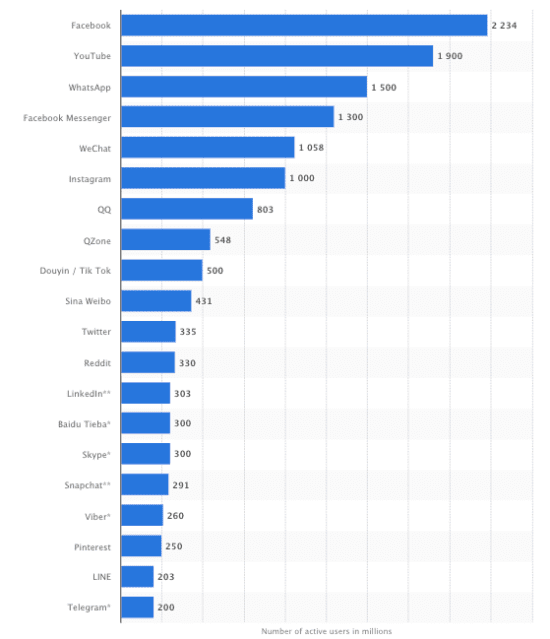
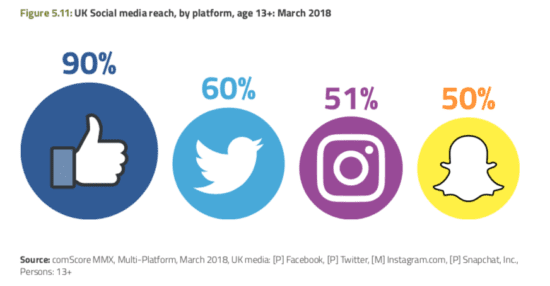
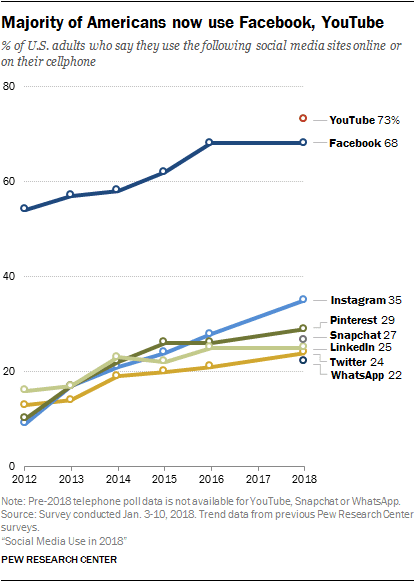
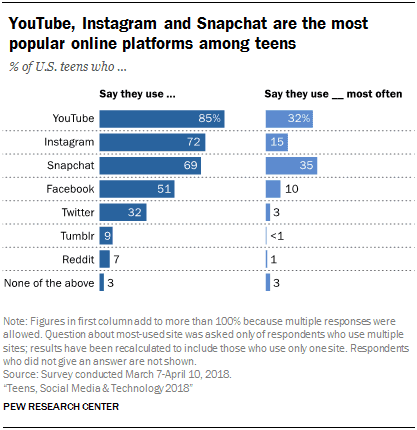
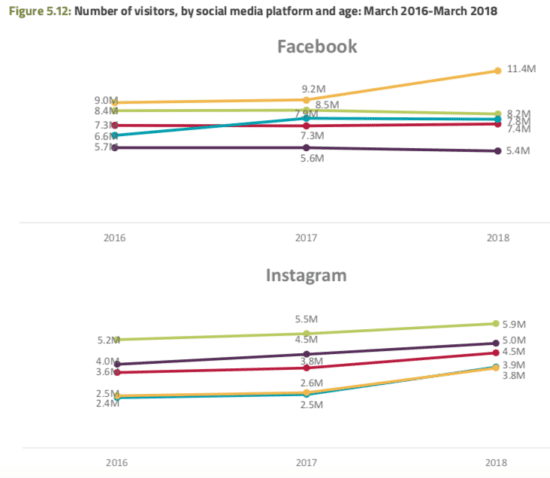
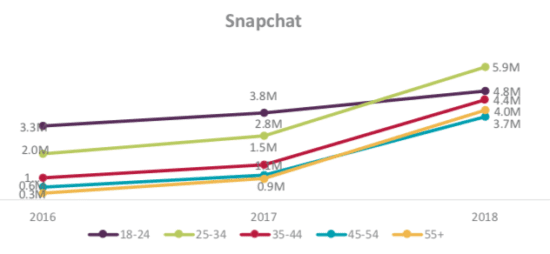 This comparison of changes in monthly active users shows that although Facebook is declining in some demographics such as 18-24 and 25-34, it and Instagram are still growing rapidly overall. Snapchat has also had significant growth.
This comparison of changes in monthly active users shows that although Facebook is declining in some demographics such as 18-24 and 25-34, it and Instagram are still growing rapidly overall. Snapchat has also had significant growth.
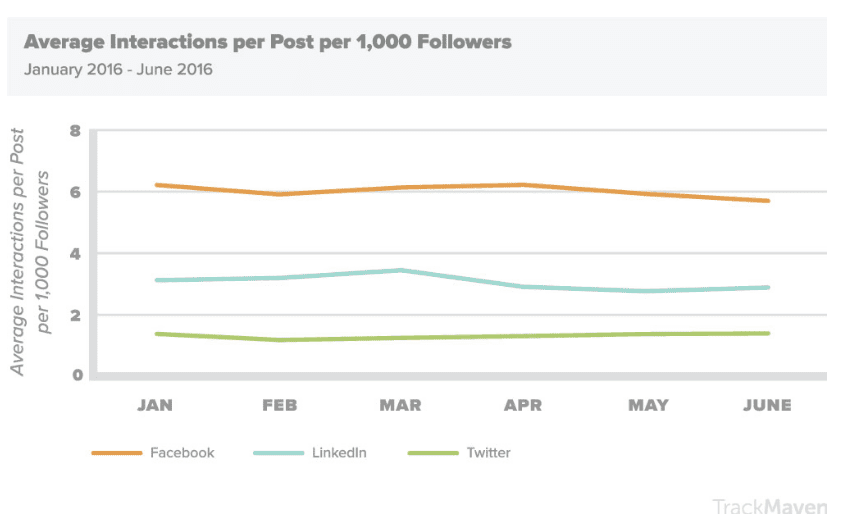
























Global social media research summary 2018
Our compilation of the latest social media statistics of consumer adoption and usage
Social networks are now so well established, that there is a core 'top 5' social networks that don't change much from year-to-year. But, as we'll see in this post, the most popular social media sites vary a lot by level of usage in different countries and demographics. Understanding these differences in popularity of different social networks is really important when targeting specific audiences. When comparing the most popular social networks it's best to review them by active account usage, not just the number of user accounts. We'll also see in this summary that some social networks are growing more rapidly than others while some are now in decline.
2018 social media stats update
We'll keep this post updated during 2018 as the latest statistics are published drawing on our recommended top 10 digital marketing statistics sources. We'll be pointing to new data around social media channel penetration in the US from Pew Internet, as well as interactions based on research by Trackmaven, but first, we present the answers to some of the key questions marketers should consider when deciding on how to invest their time in social media. Since it is still early in the year, many graphs will have to rely on stats from Q4 2017 until the stats for Q1 2018 are released.
Q1. What is the overall popularity of Social Media globally?
Each year, at the start of the year, We Are Social update their massive global compendium of stats which gives some great insights into the world of social media. It's a great download for presentations. It's particularly interesting how far some countries are diverging in terms of social media use, and surprising that Western Countries are actually lagging a fair way behind in adoption rates.
Some of the key takeaways from their Global Digital Report 2018 include:
- The number of internet users worldwide in 2018 is 4.021 billion, up 7 percent year-on-year
- The number of social media users worldwide in 2018 is 3.196 billion, up 13 percent year-on-year
- The number of mobile phone users in 2018 is 5.135 billion, up 4 percent year-on-year
Annual growth continues apace, especially in active mobile social users - 39% penetration up 5% from 2017.
Share of web traffic by device highly favours mobile at 52% (+4% year-on-year change), whilst Desktop remains in second place with only 43% of device share to all web pages, down by 3% year-on-year.
Northen, Western and South Europe and North America have the largest internet penetration with between 74%-94% internet users compared to total population.
The global increase in social media usage since January 2017 is 13%. Saudi Arabia has the largest year-on-year increase in social media users since January 2017 (32%), a 17% increase compared to the global average. Other countries with the largest social media usage increase includes India, Indonesia and Ghana as technology is improving and social media becomes easily accessible to more of the population. U.A.E, South Korea and the UK have the slowest increase with <5%.
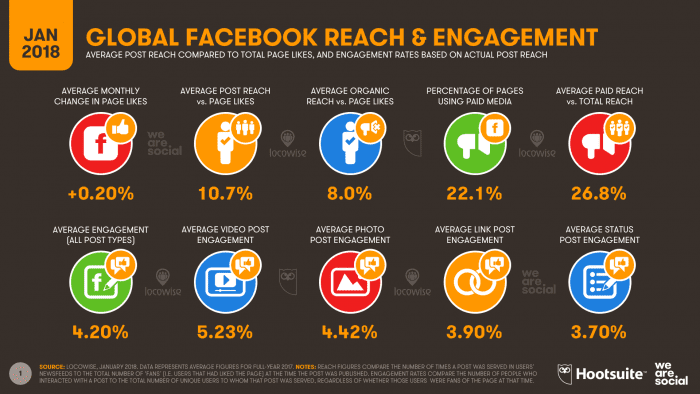

With Facebook having the most daily active users compared to other social networks it's important to know how your content may potentially perform and what features to use to optimize the reach of content. There is a 10.7% average post reach vs page like and 26.8% average paid post reach vs total reach. Facebook is a great social platform for organic and paid opportunities with a huge potential reach - just remember to target content to business personas to gain quality leads.
The full report from we are social contains a massive amount of data across 200+ slides. It provides country-specific data for the vast majority of the world, so you might want to check out the slides of the countries in your core markets to get a better idea of the current state of social in the areas you operate.
Q2. Which are the most popular social networks?
The latest insight from the comScore panel in their 2018 Global Digital Future in Focus compares the popularity of social networks by share of time (for December 2017) gives this data based on their home panel for the US, Canada, France, Germany, Italy, Spain, UK, Argentina, Brazil, Mexico, India, Indonesia, Malaysia. We have more detailed information on the UK and the US later in this article.
Most popular social networks based on share of minutes
You can see this is a sea of Facebook blue, so this shows that despite the negative media hype about Facebook it is going to remain a major audience channel for some time.
In the UK you can see that Instagram accounts for around 10% of social media minutes, so if you are not already exploiting the latest Instagram ad techniques, then it's worth looking into these, see our digital media cheatsheet for more details.
This compilation of the most popular social networks worldwide by active users (October 2018) prepared by Statista using data from the Global Web Index panel gives a clear picture of the number of active users (in millions) with Facebook ruling supreme. This won't be a shock to anyone! With over 2 billion active users it holds the majority market share. Google's YouTube is second with Facebook-owned, WhatsApp and Messenger not far behind. Facebook's Instagram platform has fewer than half of the visits of Facebook...

Following from this, we have predominantly APAC favoured platforms, with QQ, WeChat and Qzone all with over 600 million active users, highlighting the array of social platform offerings in the APAC. We then see a cluster of predominantly western social media networks in Tumblr, Instagram, and Twitter.
United Kingdom Social network popularity
The latest OfCom Communications Market report gives this summary for the most popular UK social networks as of March 2018.

Q3. Which are the fast-growing social networks?
Every marketer has limited time for social media marketing, so which fastest growing social network should you focus your efforts on?
United States Social network popularity
This Pew Research Internet Survey data on gives more detailed insights on US social media usage and growth rates.

It also reports social media teen use in US from a report Teens, Social Media and Technology 2018.

This comScore panel data from the Communications market report shows growth ratest based on demographics in the UK for Facebook and Instagram:

The report also shares data on Snapchat growth:
 This comparison of changes in monthly active users shows that although Facebook is declining in some demographics such as 18-24 and 25-34, it and Instagram are still growing rapidly overall. Snapchat has also had significant growth.
This comparison of changes in monthly active users shows that although Facebook is declining in some demographics such as 18-24 and 25-34, it and Instagram are still growing rapidly overall. Snapchat has also had significant growth.Q4. How do social users interact with brands on social?
Knowing how to behaviour / post on social media is also important as this is reflective of your brand personality and consequently influencers social uses to buy or unfollow! Social media is increasingly being used as a customer service platform where customers and potential customers want answers quickly and in real-time. Only 27%of social media user respondents will be prompted to purchase products after seeing behind the scenes content shared on brand social pages.
51% said that they would unfollow brands on social media if they posted irritating posts and 27% said they would mark/report the brand and page as spam and block them. This is why posting relevant, interesting content that resonates with your target audience and social users is important in retaining your Reach and Engagement with potential customers.
Q5. Which is the most engaging social network?
Another factor which determines the time we put into social media marketing is the engagement of the audience. Here we again see the dominance of Facebook - it's also got the greatest engagement in time according to this insight from the US consumer panel from comScore.
comScore has also published a more recent update on engagement in the UK comparing Facebook vs Twitter vs Instagram vs Pinterest vs Snapchat.
The above chart from Comscore shows engagement in terms of time spent on the platform vs reach among the millennial demographic. It's interesting to see how effectively Facebook dominates, but also interesting to see how well Snapchat and Instagram are doing in terms monthly usage per visitor. For more Snapchat stats, see our post on Snapchat Marketing Statistics.
Facebook's dominance is truly extraordinary. Not only does it take the top spot, it's other platforms also take 2nd and 3rd respectively. Facebook Messenger has an impressive 47 penetration, and Instagram (also owned by Facebook) comes 2nd for engagement.
In this recent chart from Pew Internet below, we can see in terms of active daily use Facebook is also in the lead. 76% of users log in daily, whilst 51% do for Instagram (owned by Facebook). Twitter manages just 42% of users login in daily, only just over half the Facebook figure.
Q6. What are the different interaction rates in social media?
TrackMaven analysed 51 million posts from 40,000 different companies over 130 industries to establish which social networks achieve the greatest engagement per follower. The results show that Instagram absolutely dominates when it comes to interactions per 1,000 followers. In fact, it is so much higher than the other channels we've had to include a second chart just to show the difference between Facebook, LinkedIn and Twitter!

As you can see, Instagram dominates, but when it comes to the other networks Facebook has a considerable lead on Twitter and LinkedIn. This is in large part because people tend to post a lot more on Twitter because it doesn't have an algorithm that only serves posts to a small section of an audience. This has turned Twitter into a bit of fire hose of content where companies have to share more and more often to be heard through the noise. This has resulted in lower engagement per post.
US Social media adoption
US consumer technology adoption specialists Pew Research Center released a new set of data on US Social Media USon October 8th which shows the latest social media trends and how far it has permeated society. Looking at data from the past 10 years, it charts the meteoric rise of social media.
10 years ago on 7% of the US population used one or more social networking sites. Now that figure has increased almost tenfold, to 65%. Of those who use the internet a massive majority of 76% of American's use social media.
Social Media has grown massively, but it's growth is now starting to plateau. Interestingly the over 65s segment are now driving growth, as other age groups have plateaued completely and use is hardly growing it all. Among the 50-64 age cohort, use hasn't increased since 2013.
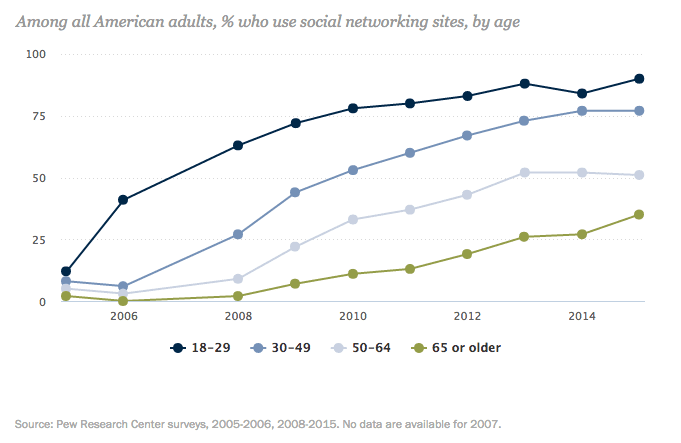

Social network popularity by country
This is a great visualisation of the popularity of social networks based on the interviews in the GWI report. If you pick out your country it's probably way behind the countries in which these four core social networks are most popular. Indonesia, Philippines, Mexico, India and Brazil are in the top 10 for each with significantly higher levels of use than the US, UK and European countries.
Use of social networks by different demographics
This chart is striking for the similarity of usage across different age groups. It shows that the social networks are now at a stage of maturity where they give opportunities to reach all age and gender groups. The exceptions to this are Instagram and Tumblr which are clearly popular with younger age groups.
By Dave Chaffey
Digital strategist Dr Dave Chaffey is co-founder and Content Director of Smart Insights. Dave is editor of the 100+ templates, ebooks and courses in the digital marketing resource library created by our team of 25+ Digital Marketing experts. Our resources are used by our Premium members in more than 100 countries to Plan, Manage and Optimize their digital marketing. Free members can access our sample templates here. Please connect on LinkedIn to receive updates or ask me a question. For my full profile and other social networks, see the Dave Chaffey profile page on Smart Insights. Dave is a keynote speaker, trainer and consultant who is author of 5 bestselling books on digital marketing including Digital Marketing Excellence and Digital Marketing: Strategy, Implementation and Practice. In 2004 he was recognised by the Chartered Institute of Marketing as one of 50 marketing ‘gurus’ worldwide who have helped shape the future of marketing.
23 Amazing Statistics on Internet and Social Media in 2019
This year has been an explosive one for the social media world. With all of the online regulations, Twitter hashtag revolutions, and Facebook privacy scandals, the internet has offered a plethora of drama.
But even so, users are not slowing down on their internet use, with many of us spending a large portion of our day on the internet, connecting with friends, family, and the world at large.
Read on to learn about our similarities and differences, and see how we engage with the ever expanding, ever more dynamic world wide web.
Trends in Internet Use
1. The GDP of countries appears to strongly correlate with internet penetration, with the wealthiest countries having higher internet penetration and vice versa. The difference between internet users in North Korea and Qatar is 98.4%
Despite its size and population, North Korea has an internet penetration of just 0.06%, while Qatar and the United Arab Emirates have a massive 99% of its citizens connected.

2. In the past 18 years, Africa has seen a remarkable increase of almost 10,000%, while North America has had a minute 219% increase primarily due to early adoption.

3. Internet use is most widespread in North America as well as Northern and Western Europe with over 90% penetration, while remaining low in Central and Eastern Africa with less than 20%.
This is mainly due to less infrastructure availability.

4. People in Thailand spend more time online per day than anywhere else is the world. They average out to 9 hours 38 minutes spent online every day, while the average American spends a far more modest 6 hours 30 minutes surfing the web.
However, it is no surprise that Kenya and Morocco spend less than 4 and 3 hours online per day respectively.

5. What is the most popular OS in the world? The high cost of Apple devices has rendered them a less common choice of OS, with a combined 18.47% total between Mac OS X and iOS. However, Android is dominating with 40.06% followed closely by Windows with 36.74%.
Linux is used with the least frequency, likely because the fact that it’s open source means it’s constantly changing, making it challenging to use if you don’t have technical know-how.

6. When it comes to browsers, you can see that Chrome beats out all other browsers by a mile.
The popularity of Opera on the poorest continent is likely due to the fact that Opera requires less data than Chrome and is therefore a better option if you don’t have the latest device or biggest data package.

7. With 90.61% of users choosing Google as their search engine of choice, it is no wonder the phrase “Google it” has become so famous.
The main reasons for Google’s widespread use includes relevant ads and fast results. Plus, Google comes pre-installed on Android devices, the most popular operating system.

Trends in Social Media
8. Facebook is still the most popular social media platform across the board, with more than 1 billion people actively using the social media site.

9. Facebook has over 2 billion monthly users, of which more than 1 billion access the site very regularly. YouTube has just over 1.5 billion users accessing content, making it the second most popular platform.
Pinterest brings up the rear with just 200 million monthly users

10. Although Facebook is the most popular social media platform on every continent, it faces the stiffest competition in North America, where Pinterest has a claimed a large 30.42% of users.
This is likely because of recent scandals involving user privacy which have been more widely reported in the US than in other parts of the world.

11. While most social media platforms are used roughly equally by men and women, the ones with the biggest differences always show a higher usage by women. These differences can be seen mainly with Pinterest, where there is a massive 25% difference, which one study shows is used by women more as a motivational or inspirational tool, and by men more as a bookmarking tool.

12. In general, the use of social media platforms decreases with age. However, LinkedIn and WhatsApp increase in the 30-49 year old range by around 5%.
LinkedIn is popular with this group is because it’s a professional networking site, and 30-49 year olds are at the stage where career development is most critical. On the other hand, WhatsApp-use in this age group likely has less to do with their love of the app and more to do with the convenience.

13. The more educated the person, the more they tend to use social media. While there is no obvious reason for this, it may due to more educated people having jobs that involve computers, networking, or marketing. People with a college degree use social media 10% more on average that those with some college, and around 20% more than those with high school diplomas or only some high school.

14. The countries in which Facebook use is most dominated by men are those that are patriarchal and in which gender separation is the norm, such as Yemen (85%) and Afghanistan (84%).
In fact, in the countries with male-dominated social media, women are often discriminated against sexually, physically, and educationally (many women can’t read or write).

Trends in Messenger Apps
15. Facebook and WhatsApp are the most commonly used messenger apps, and are both owned by social media giant Facebook.
Notably, in China, where both Facebook and WhatsApp are blocked by the government, the Chinese-owned WeChat dominates. Similarly, the Japanese favor the Japan-based Line, and South Koreans favor the Korea-based KakaoTalk.

Trends in Device Use
16. 52% of web surfing happens on mobile phones, which shouldn’t come a surprise. What is surprising is that while 25% of all online users use a VPN to connect to the internet, they still prefer to connect with a desktop or laptop (43%) instead of a tablet (4%).
The reasons for using a VPN can vary from bypassing online censorship to accessing geo-blocked content as well as security reasons, which is why it makes sense that ExpressVPN and NordVPN are the two most popular VPNs in the world. These two secure providers consistently bypass VPN blocks and online censorship for users, regardless if they are using a smartphone, laptop, desktop, tablet, or another device.

17. The internet was already being used on more mobile devices than desktops in 2018 – a trend that became even more pronounced in 2019 when a further 6% of people switch to mobile devices. This trend is likely to continue in the coming years as mobile phones are being designed with more capabilities and features than ever before.

18. 51.2% of people spend time on their mobile devices rather than on their desktops (44.66%).
From tracking our fitness routines, to finding the quickest route for our commutes, to selling that old couch, there’s an app for basically every element of modern life.

19. Desktop devices are used more often during the day between 10am and 5pm when workers are in their cubicles or offices, while mobile devices are more popular when people are off the clock at home, particularly after 8pm in the evening.

20. Certain types of websites – like those dedicated to adult content (13%) and gaming (10%) – are seeing a large increase in access from mobile devices, especially when compared to news and health sites, which only get a combined 3%.
This is likely due to advancements in mobile technology. Specifically, mobile phones are now powerful enough to accommodate websites and platforms that stream video and normally require more processing power than what phones used to be able to provide.

21. Even in affluent regions, like Europe (15%) and North America (17%), there are still a fairly large number of people who do not access the internet on their phones.

Trends in Digital News
22. 59% of people still prefer to read the news online rather than listen to or watch it.

23. The most common ways for people to engage with the news on social media are the ones that require the least effort, such as clicking links (60%) or “liking” (58%). Engagement drops for more labor-intensive interactions, such as posting news stories (36%) or discussing current events (31%).

You’re welcome to use and share the images or data from this page, but please provide attribution.


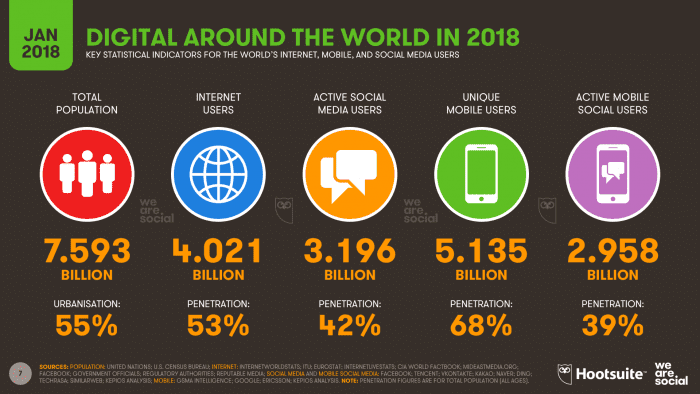
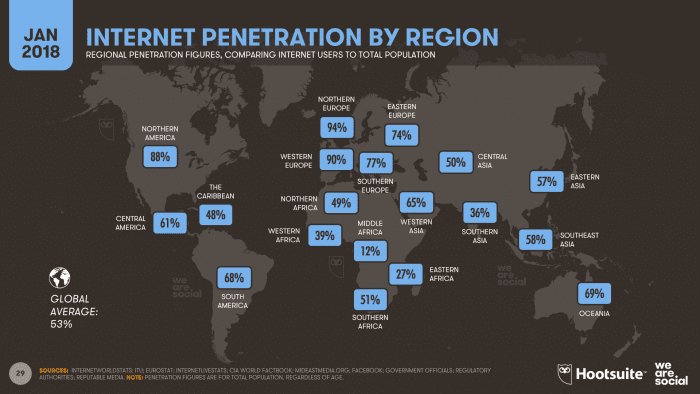
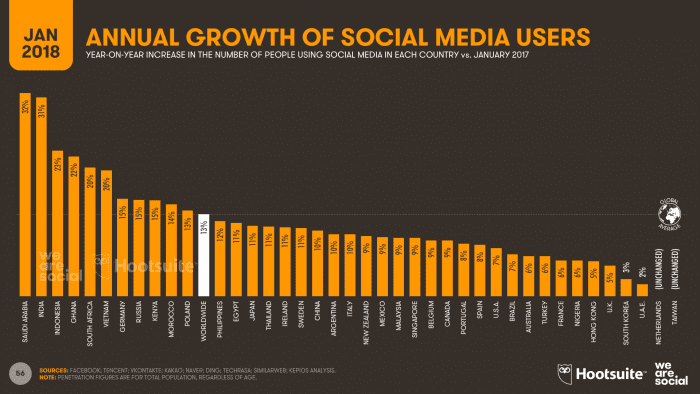
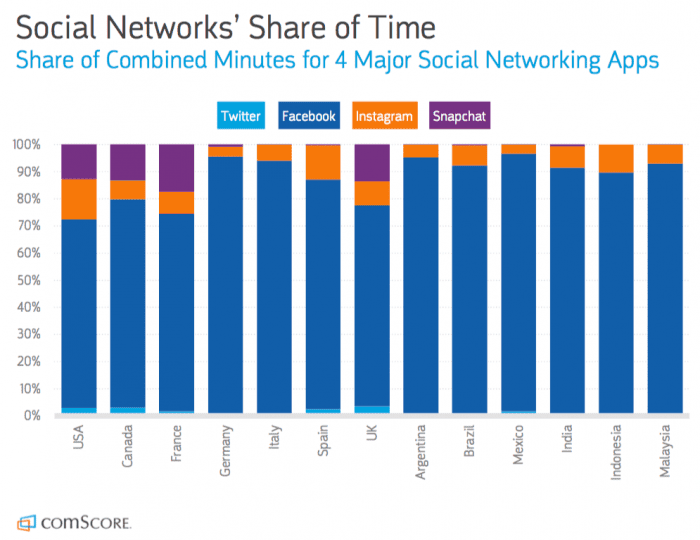
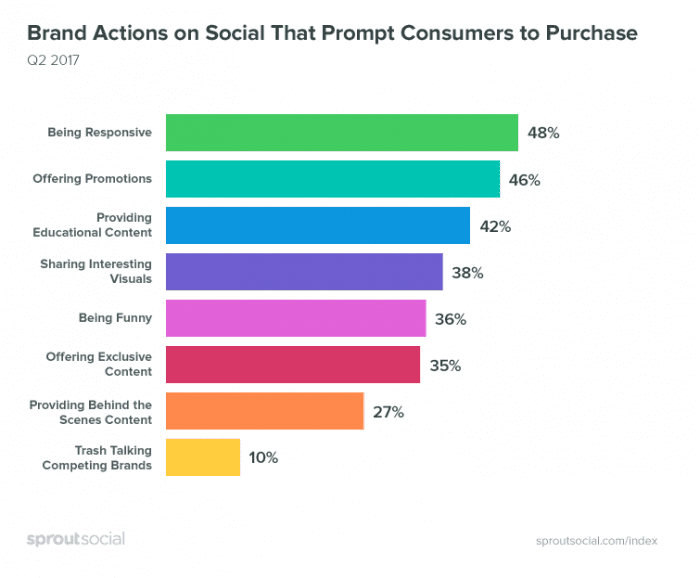
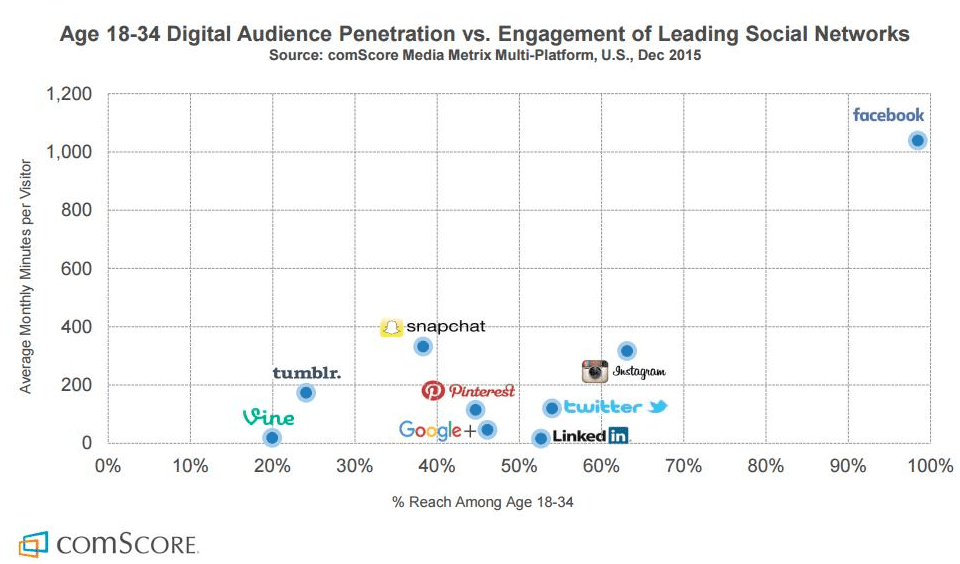
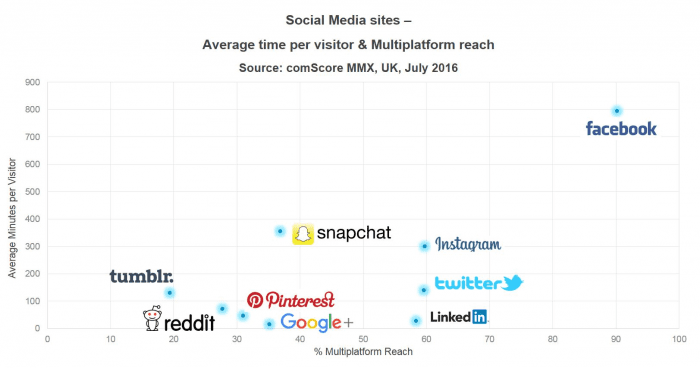
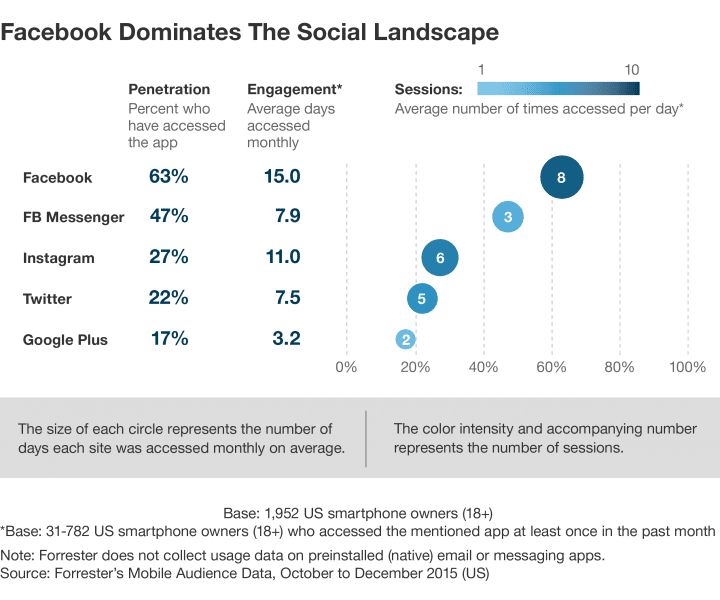
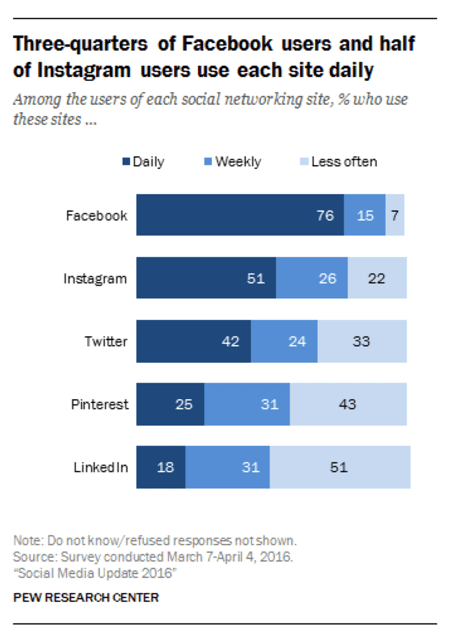
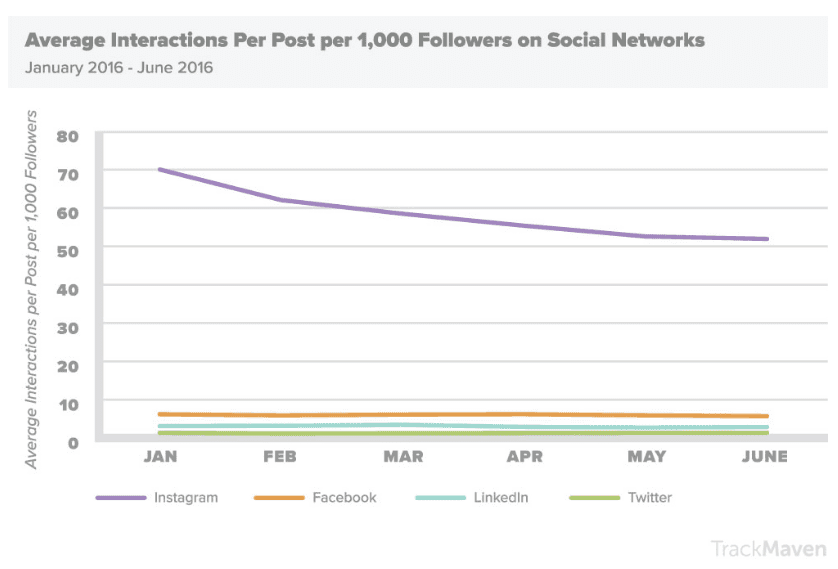
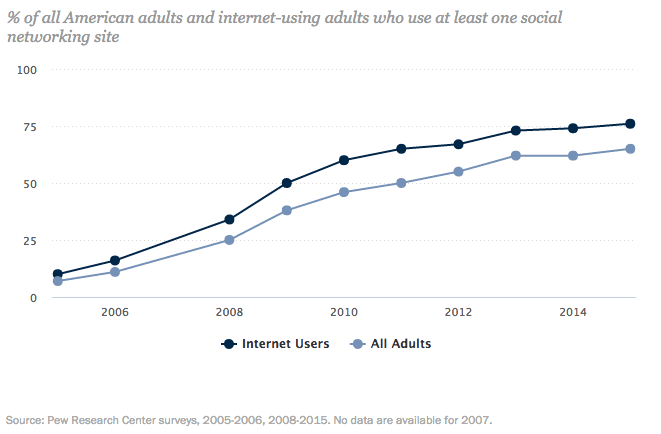
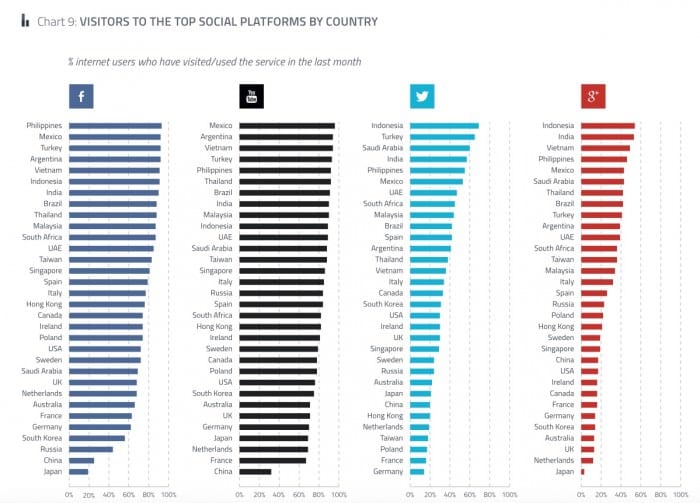
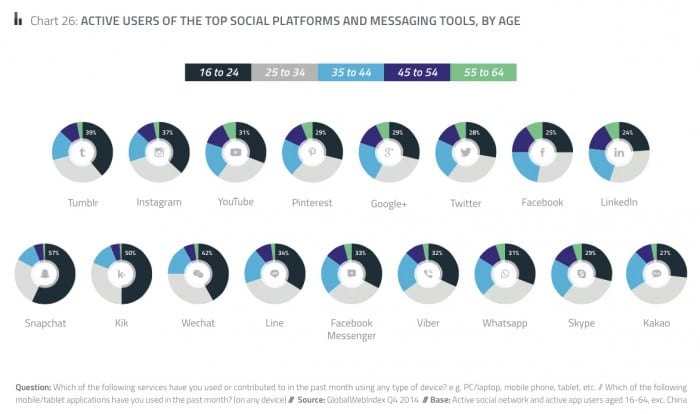
No comments:
Post a Comment